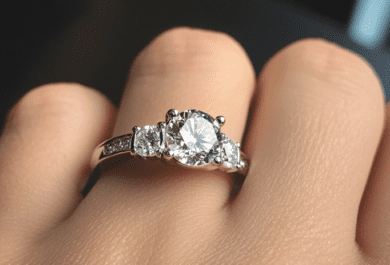David S. Atlas 2/10/2007
I love fine gems, well cut diamonds and quality jewelry. Please don’t shoot the messenger, as I have bought, sold, owned and appraised countless millions of dollars worth of these beautiful things since 1967 when I entered the jewelry trade. I’ve been fortunate to have made a decent living, saved enough money to have a nice retirement someday, traveled enough, and lived well on these fine things, but I never considered them as investments. My investments were stocks, bonds, and a series of homes which were chosen to secure funds, keep up or beat inflation and to preserve capital. I also spent money on things that were not investments. Things that get used up, things one enjoys that don’t last nearly forever, stuff around the house, cars, fine dining, clothes and vacations. None of those were ever thought of as investments although there was value in many of them.
Investments should be durable and at least hold their value with inflation or increase in value faster than inflation. They should be able to be readily converted to cash or exchanged for another investment whenever one wishes to do so. A ready market is a requirement for a sound investment. Look at the stock market or the gold market as great examples of a place where parties can buy or sell at a moment’s notice. These places have small costs associated with them for buying or selling, but these costs do not ruin the potential of the investment.
In the past several months I have been increasingly questioned by consumers about items of jewelry, gems and diamonds which are being flogged to them as “investments” or of “investment quality”. This just isn’t appropriate terminology for such items. Consumers seem endlessly na?ve about what is or is not an investment. I figured an article on this subject is overdue even though many similar have been written in the past 30 years. I’m not the first to give a warning, but it has become apparent that not enough consumers are informed about where to put their savings and how to secure their future. Too many consumers accept a hard sales pitch that jewelry, gems or diamonds somehow can help to insure their future security and savings. For the vast majority of the public, it just isn’t the case. Like I said earlier, I love these fine and beautiful things, but that does not make them investments.
Let’s just look at an example. A diamond which has a full wholesale cost of $10,000 might sell at a low mark-up 10% profit equaling $11,000. This diamond did not cost the wholesaler $10,000 but probably had an actual cost in of somewhere in the $6,000 to $8000 range somewhere back in the chain of supply from the cutter. The cut quality, relative rarity of the diamond, and the desirability of its shape all have something to do with mark-up inside the wholesale chain of events. For now, just use a $7,000 average cost. The consumer who just bought this diamond for $11,000 decides in a month that they want to sell the stone. Real buyers know that $7,000 is the usual cost when they are looking for stock supplies of such stones. It is nearly impossible for a consumer to find a buyer who needs that particular diamond on the day the consumer wants to sell it. Sure, accidents can happen, but that is such an unusual case that one should never plan on it happening to them. You could buy a lottery ticket and win first prize more easily.
The reality is that you would be doing well to clear $5,000 to dump this $11,000 diamond on a given day you want to sell it on. While a buyers market exists, it is a market with very high buying or selling costs associated with it. It is a very, very distant relative of the stock exchange or the gold market scenario.
With this example one would need to have a $5,000 liquidation value grow to $11,000 via inflation and price increases before one could get back the dollars that were paid. These would now be highly inflated dollars, worth less per dollar than on the date of purchase. If one calculated an annual, compounded 6% price increase annually, then it would take just under 14 (fourteen) years to just come to where one could get back their original dollars. Of course, the retail, in theory would also have become far higher in these 14 years, too. Your original money would be nowhere near as valuable as it once was a decade and a half ago. If you had paid more than the minimal $11,000, say $14,000, for this same diamond, you would only be waiting longer and in even worse shape. Now you tell me, what kind of “investment” is that? I’d suggest it was a rather poor one, at best.
The case for colored gems is even worse. There is no DeBeers holding up the market supply and values. There is little marketing to create demand. Colored gems are not evenly distributed. Fewer buyers are open to the public need to sell. Knowledge of value is not common. In general, colored gems are a worst case market except for the top 1% of the finest examples. At the very top are exceptions to the rules. The very finest are possibly fair investments, but the typical consumer in mislead that any gem of a particular origin or variety is equal in investment value to any other of the same type. This is not true and is the cause of many a mistaken investment. All Burma rubies are not equally rare or valuable. All Paraiba tourmalines are not equally rare or valuable. Many colored gems said to come from one location may, in fact, come from some other place where the gems just look similar. Treatments and enhancements are often not revealed. Simply put, don’t fall for promises of a bucket of gold at the end of a rainbow. The rainbow is beautiful to contemplate, but you can never reach it, touch it or come to the end of it. It is an elusive, false hope being held out for your imagination to capture. Don’t allow yourself to act on a dream. Dream all you want, but put your hard earned money into investments which have solid track records of performance. As an expert, I promise you that the wonderful items of jewelry, gems and diamonds I get to examine and evaluate on a daily basis do not qualify as valid investment vehicles for 99%+ of the public. There are always small exceptions, but if you happen to be one of them, no problem. You are just lucky, and very wealthy, too.
Now, what is the investment you are making when you buy jewelry, gems or diamonds? You are spending money just like when you invest. You get an annual return, too. The return is mostly in PLEASURE. You get to see someone who you made very happy with a gift. You may have bought something for yourself which makes you all warm and satisfied inside every time you see it. Isn’t that reward a real dividend? Of course it is.
Do you love something which is beautiful? Do you wonder how nature and the skill of man have given you something that is a work of art? Do you ponder the great unknown forces of the universe which either though a master hand or pure accident created these natural minerals and metals which can make our minds so pleased? I do every day.
I am writing this for consumers who have been approached to make an investment in jewelry, gems or diamonds to consider BEFORE taking the plunge. You buy these things for their rarity, beauty, romance, symbolism, and commitment. You should rarely, if ever, consider them a storehouse of value for some time in the future should you decide to sell them. Yes, they may have considerable value later on, but don’t start the buying decision on a basically false promise and premise. When you, as a consumer, make a buying decision knowing all the proper facts, you will be a far happier person later on if you ever need to sell or when you are doing your estate planning.
Jewelry, gems and diamonds are best thought of as personal investments in our temporal world of love, relationships and intimacy with nature. “You can’t take it with you.” is a phrase to think of when you spend your money on something wonderful as a gift for a person you cherish. It isn’t even bad to think of this when you spend some of the same money on something for yourself, too. Enjoy the time you are living in today while you have it. There is no promise that you’ll be here for the next sunrise. Plan for the future with real investments. Plan for today with those things which give you beauty, happiness and joy.












